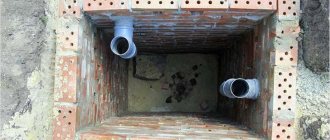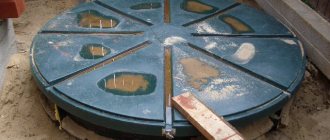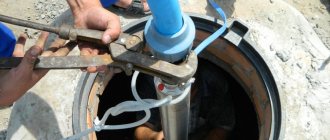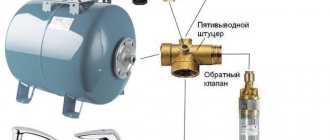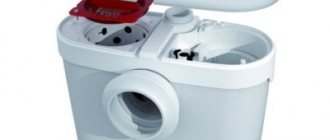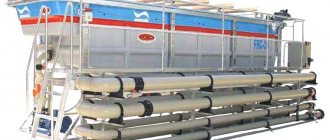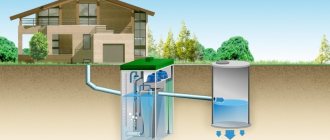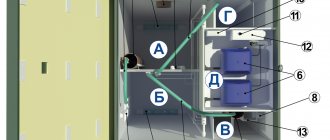Sewerage in the basement is often planned by homeowners when it comes to installing communications in a country house. In addition, showers, baths, swimming pools and other rooms with a high need for water are sometimes equipped on the underground floors. In this and other cases, there is a need for effective waste disposal.
The main problem is that the building's sewer network is located above the level of drainage from the basement. That is why the use of a traditional wastewater disposal system (when it goes down under its own weight) is excluded.
In this case, experts recommend purchasing and installing systems that will forcibly pump wastewater. In addition, when installing a sewer system in the basement, it is worth paying attention to the issue of ensuring safety and sanitation, since under unfavorable circumstances the drainage can flow back. To organize a reliable and safe system, it is necessary to first identify the category of wastewater that will be removed from the basement. There are two categories: the so-called clean and dirty wastewater.
With “clean” wastewater, you have to deal with water that does not contain solid inclusions and suspensions. This type of wastewater includes water coming from washing machines, showers, swimming pools, etc. The category of “dirty” wastewater includes any wastewater that comes from a toilet. A toilet on the basement floor is quite difficult to install correctly, so if possible, such work should be carried out by professionals.
The relevance of the problem of drainage from basements
The ground level of buildings is increasingly being mastered by the owners of the building. This is due to the need to rationally use all available space. The basement is not always an ideal option for creating a bedroom, living room or children's room there. It is better to use it as a sports room or a second kitchen. In this case, the question arises about creating a bathroom and bathroom.
Sewerage is one of the main elements
Basement drainage is a pressing issue that requires careful planning. The basement floor is below ground level, while all the main sewerage nodes are above. Therefore, it is necessary to provide for effective drainage with raised wastewater. Severely and moderately polluted wastewater must be lifted using special equipment.
Sewerage in the basement: installation features
In a private house, the role of the basement is difficult to overestimate. In addition to storing supplies for the winter, it increasingly serves as a bathhouse, shower room or even a swimming pool. To avoid excessive dampness, it is necessary to take into account some installation nuances:
- preliminary preparation. Before starting work, you must check the availability of all tools and parts: riser, plugs, bends, adapters, sealant, fasteners, etc.;
- quality materials. If you want your sewer system to last as long as possible, choose pipes only from high-quality plastic. As for the size of the pipeline, it is better to give preference to a large diameter, but the general riser is installed taking into account the amount of free space. When dealing with the basement of a multi-storey building, a riser pipe should be selected with a range of at least 100-110 mm;
- reliable fastening. Strong fixation of the riser is a prerequisite for quality work. Otherwise, plastic pipes that are not fixed rigidly enough may become filled with excess liquid, become heavy and, accordingly, deform. Installing the pipes also requires a smooth surface, so be sure to level the areas where the bathrooms connect.
For better sealing, it is recommended to apply silicone or grease to the seal rings.
The need to separate the disposal of heavily and moderately polluted wastewater
Before you begin installing pump equipment or other elements of the sewer system on the basement floor, you should find out the ratio of the waste being pumped out. The choice of special settings depends on this.
For example, when installing one toilet, it will be enough to install a sololift - a device with low power required for pumping out fecal waste. It is used for the removal of heavily contaminated waste.
Interesting! As a rule, the ground floor is used to accommodate several sources of water volumes, which means it requires calculation of future water consumption. If the consumed volume of water does not exceed 1 m3, then a sololift will help cope with this task.
In this video you will learn more about sewerage:
Sololift is a universal pumping station designed for fecal wastewater. They can be used to remove various types of sewage waste. If the norm is exceeded, it is planned to create two systems. For example, there is a swimming pool in the basement. This means that you need to install a separate pump, which will simply need to pump out water without much contamination.
Mounting methods
Metal pipes do not respond to temperature changes. Plastic pipeline is characterized by a high coefficient of thermal expansion. As the temperature increases, both inside the pipe and in the room, it lengthens.
Thermal expansion is compensated by various methods, including the method of fastening.
- Rigid - the clamp tightens the water pipe, ensuring its complete immobility. These areas are called the point of rigid fixation; they are located below the bell. A crimp and support clamp is used.
- Floating - the clamps are not tightened; plastic clamps are selected with a slightly larger diameter than the pipe. When expanding, the pipeline can move in the longitudinal direction. For floating fixation, support and guide clamps are used.
Pipeline installation
The frequency of use and the sequence of the floating and rigid method of fixation to the wall is dictated by the structure of the sewer system.
- Fastening to the wall requires a minimum distance between the water conduit and the wall. If some distance is necessary, then special metal brackets are used.
- A hole is drilled in the wall, a clamp is attached to the dowel, and then the pipe is inserted into the clamp and the clamping screws are tightened. It simply snaps into plastic devices.
- The frequency of fastening is determined by the cross-section of the water conduit: with 50 mm, the distance will be 40 cm, with 100 mm - 80 cm.
- Clamps are installed only on smooth areas, the distance to the bend is at least 15 cm.
- It is mandatory to fix the joints between the pipeline and the fitting.
- Installing the system to the ceiling is no different. The distance should be minimal, and the frequency is determined by the size. The method is used only in the basement, and not always.
They act a little differently in those rare cases when it is necessary to maintain a large distance between the sewer system and the ceiling in the basement. In this case, anchors with internal threads are fixed to the ceiling, a threaded rod is mounted, cut to length (the product is available up to 2 m long), and a clamp is screwed to the rod.
Types of wastewater and options for its disposal
The reliability of the sewer system in the basement of a private house should be high. This involves the use of multiple but suitable pumps. Clogging too much free space with installations is not the best solution. First of all, it is necessary to calculate the possible volume of water that should be pumped out, and only then buy equipment.
The water that forms in the basement can be classified as moderate or severe contamination. Heavy contamination is water in the toilet. Solids that enter the system must be crushed before being discharged into the general sewer system. This will ensure normal throughput.
Liquid return cut-off
The sewerage system in the basement of a private house must protect the system from reverse flow of wastewater. For this purpose, special elements, or check valves, are used. They allow waste to flow in the forward direction, but close when liquids move in the opposite direction. There are two types:
- passive valves. They work on a mechanical principle, opening under the pressure of a fluid flow and closing when the load disappears;
- active devices. As a rule, they are part of pumping units.
The first option is used on relatively small systems. If the valve fails or fails, the damage done will not be too great. Active units ensure that large volumes of liquid are cut off, which could flood the basement.
Separated sewerage system
The use of a divided system is relevant if the volume of water without solid parts is greater than without them.
If there are several points in the basement with used water, which in total gives a significant amount of waste water, you can use two options for outlets:
- Sololift for fecal matter with a separate pump.
- Several pumps of different power to supply different toilets, sinks and washbasins.
Combined disposal of various wastewater
A pumping station is an element that is capable of providing a combined discharge of various wastewater. Several sources of small water consumption that are not polluted can be diverted in this way.
A pumping station can be compared with a sololift, but with greater power and a large storage tank. Some models have a system that prevents reverse current flow. Such a pump is capable of pumping out up to 10 m3 of water per day and providing frequently used sources with a reserve.
The pumping station has one significant drawback - increased noise level. Today there are already models in which this problem has been eliminated. Background noise is reduced at the same power.
Don't forget about the pumping station
How to provide backflow protection
The basement, due to its location, requires special attention in terms of creating a sewer system. Pipes that are located at the bottom are most at risk of blockages and contamination. The system is constantly overcrowded.
Reverse flow is a process in which the system overflows and water begins to flow back from the outflow nodes. In this case, you can flood the room with water with an unpleasant odor.
There are effective ways to prevent basement water from backflowing:
- Install equipment that has built-in current resistance. Today there are already many installations that have this possibility. Availability in a specific model must be asked upon purchase.
- Install intermediate backup tanks installed near the house, as well as blocking valves to prevent backflow. The disadvantages of this method include clogging of sewer pipes in the basement.
Disputes among professionals continue to this day. They argue that the likelihood of a drain backflow is so low that it is not worth the cost. Others say it's more important to keep your space safe and sanitary than to think about the money you're spending.
How to choose the right household pump
Today in the world of construction, there are two main types of pumps for sewage installed in the basement:
- household (in most cases applicable to country houses, cottages, cafes, small hotels, clubs, shops, etc., since they are capable of pumping wastewater from both one and several consumers);
- industrial (installed mainly in multi-storey high-rise buildings or at substations that are connected to a city or autonomous sewer collector).
Household pumps differ depending on the purpose and place of use, as well as design features. For example, on the construction market you can find pumps that are customized specifically for the consumer or for installations intended for pressure sewerage, which are installed in septic wells or special pumping stations.
Household pumping devices, in turn, are divided into:
- drainage;
- fecal.
Pumps of the first type can pump small elements of solid waste along with water. They are used not only for pumping wastewater, but also for pumping groundwater from basements and cellars. To avoid damage to mechanical parts, a filter in the form of a mesh made of stainless material with many small cells is installed on the lower section of the pipe, thanks to which particles do not get inside the device.
Fecal pumps are characterized by the absence of any filters. They can pump out wastewater containing soft waste. If he comes across large fragments, a special built-in cutting mechanism copes with them. This pump is ideal for a toilet located in the basement, as the iron blades are great at shredding fecal matter or toilet paper. It is installed directly behind the toilet at a distance of no more than 40 cm.
(Quote) Do not forget that the permissible water temperature for the fecal pump should not exceed 50°C. This is described in more detail in the instructions for the toilet.
Features and advantages of operating pumping stations for draining wastewater from basements
The pumping station is a sealed container that plays the role of a mini-storage unit. In this case, wastewater is removed as needed when the container is filled. Pumping stations use special pumps that pump water up into the general sewer system in the basement of an apartment building, or directly into the drain.
The main advantage of the pumping station is the ability to install it in a bathroom or toilet at any stage, and not just during construction. If it is necessary to replace the pumping station, this can be done without difficulty by replacing the new system.
Installations with the following characteristics have advantages:
- Small in size, allowing installation in a bathroom, toilet or other rooms with a small area.
- Providing simple installation and maintenance that does not require calling specialists.
- Having a chopper.
- They have carbon filters that provide the lowest level of odors.
The sewage pumping station is capable of pumping wastewater with high temperatures. Most manufacturers assure that their models do not lose their characteristics, even if the drain temperature reaches 50-55 °C.
The power of the device also plays an important role. To provide for the average family, it is necessary to use a system that can transport wastewater to a height of up to 4 meters and a length of up to 100 meters. The sewage pumping station must have a capacity in the range from 8 to 24 m3/h.
Sewerage in the basement is the optimal solution for hiding pipes
Sewerage for the basement: which is better
Before installing the pump on the sewer, you need to find out which sewer
it is appropriate for the system. Depending on the installation method, there are two main types:
- hidden;
- open.
In the first case, pipelines are installed under floors, in false ceilings or in attached boxes. Often the installation is carried out through the ceiling and foundation. Closed pipe distribution is needed for proper installation of the external network in trenches, as well as to increase the level of heat and sound insulation during internal sewerage.
For the basement, the open type of laying is more suitable, since the pipes are placed with special supports and fastened with brackets or clamps. It is characterized by practicality and accessibility, so at any time you can inspect the pipeline and, if necessary, dismantle it, replacing failed parts.
To avoid problems with dirt particles getting stuck, the standard inclination angle range should be 2-3 cm (3-5°) per 1 m of sewer pipe.
Sololifts
As noted above, sewerage can be organized using sololifts. They are selected according to the same principle as pumping stations. The sololift must have a grinding system. In addition, there is a volume in which wastewater accumulates.
Sololift is the same pumping station, but used for rough waste. At the same time, they are small in size, so the issue of installation is not so relevant. The units have several inlet pipes, so several elements of the system can be connected to it. But Sololift has a small volume, which imposes slight restrictions on pumping capabilities in a certain period of time.
Installation of a septic tank
A septic tank is an important part in the system for treating dirty wastewater on your site
Advice: When you install a septic tank at your dacha, you should pay attention to the SNiPs (sanitary norms and regulations) in force in that area.
The drainage system is calculated at the building design stage. The trouble-free operation of the local sewerage system and the reduction of costs for its installation are influenced by location. This should take into account:
- The depth to which groundwater occurs.
- Soil freezing depth.
- The size and topography of the site, the presence of reservoirs on it.
- Soil composition.
- Waste volume.
The rules for laying pipes from the house to the storage tank, specified in the regulatory documents, include:
- Provide the lowest level for laying discharge pipes - 0.6 meters.
- Make a cut of approximately two centimeters by one meter.
- Maintain, according to SNiP, the distance to the first inspection well from the riser to 12 meters. Then place wells every 15 meters. When turning the pipe, be sure to install a well with a tray.
According to the rules, an installed septic tank or a group of devices, before filling them with a sand-cement mixture, are connected to each other by pipes using elastic couplings to ensure the tightness of the connection. The filtration field must be provided with sand and gravel cushions, through which the purified liquid must pass into the soil. From the septic tank, the outlet pipe is connected to a perforated pipe or through a special collector to perforated pipes, which are laid on a gravel bed for the filtration field.

